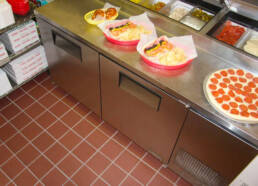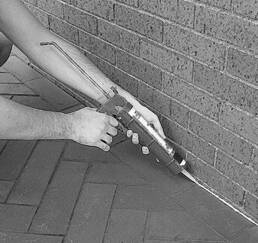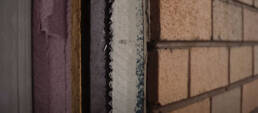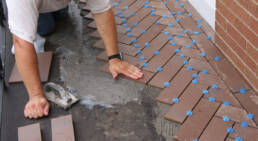New Video! Installing Thin Brick Outdoors
Metropolitan Ceramics offers both METROBRICK and Royal Thin Brick product lines. Here is a new thin brick installation video – Installing Thin Brick on an Insulated Exterior Wall. All steps of wall assembly are shown as well as a focus on installing the thin brick using tile setting methods.
Don't use this type of grout for Commercial Kitchens

Single component grouts that can be scooped directly from the bucket and applied to tiles have become increasingly popular over the last 10 years. These ready to use grouts are great for many applications, but should never be used in commercial kitchens even if the advertisement says they offer ‘all of the benefits‘ of epoxy grout. They aren’t epoxy grouts and the differences are most obvious in a commercial kitchen setting. All of them exclude environments where harsh chemicals are used in their Technical Data Sheet.
Quarry tile is the most popular floor covering for commercial kitchens because it is very resistant to anything you can throw at it. The grout you pair with the quarry tile needs to be equally resistant to harsh cleaners, grease, and other conditions found in this environment. The enzymatic cleaners typically used for commercial kitchens are designed to digest fat and grease particles with enzymes. While the best practice is to then rinse these cleaners from the floor, often that is not done. This creates oleic acid that can damage cement grout, standard epoxy grout, and single component grouts.
For commercial kitchens, Metropolitan recommends the use of 100% solids epoxy grouts designed specifically for this type of application. Generally these are advertised as industrial epoxy grouts. Common grouts in this category include Kerapoxy IEG from MAPEI, Spectralock 2000 IG from Laticrete, and CEG-IG from Custom Building Products. There are others available as well. These grouts take practice to install as they are often stiffer and more challenging to clean than standard epoxy grouts. However, they are much easier to work with than the old technology, furan grouts. When in doubt, consult the installation products manufacturer to get their grout recommendation for your installation.
An Important Part of Every Tile Installation

Properly managing movement and expansion joints is an important part of every tile installation. Knowing how and where to include expansion joints can be one key to the success of the overall tile work.
The Tile Council of North America (TCNA) includes an entire section (EJ171) of their handbook covering movement and expansion joints. The section includes information on location and frequency, width, materials, and installation. The section also includes details on various types of joints relating to both construction and tile installation.
The TCNA has a F.A.Q. section about movement and expansion joints on their website @ http://www.tcnatile.com/faqs/53-expansion-joints.html
Don’t under estimate the importance of adding the correct expansion joints to your tile work. This important step will help ensure a sound tile installation.
If you have questions about movement and expansion joints in tile work or would like a copy of the TCNA Handbook, visit the TCNA website @ tcnatile.com or call them @ 864-646-2821.



